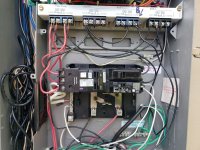a. 120 VAC pool/spa lights must be connected to a Ground Fault Circuit Interrupter (GFCI), with an appropriately rated circuit breaker. See Figure 1.
For Canada, 120 and 12 VAC lights must have a Ground Fault Circuit Interrupter (GFCI), and have an appropriately rated circuit breaker.
b. The Junction Box (or 12 volt light models, the low voltage transformer) must be located at least 8 in (20.32 cm) above the maximum water level and at least 4 in (10.2 cm) above the ground level or pool deck whichever provides the greater elevation.
The junction box shall be no less than 4 ft (1.22 m) from the inside wall of the pool, unless separated from the pool by a solid fence, wall or other permanent barrier. See Figure 1.
The Junction Box should also be located at least 48 in (122 cm) minimum (3 m (10 ft.) Canada) from the edge of the pool, see Figure 1.
c. The light fixture and all metal items within 5 ft. (153 cm) minimum of the pool must be properly electrically bonded.
d. Bond the niche-fixture housing to all other metallic items within 5 ft (1.53 m) of the pool, using a No. 8 AWG bond wire.
The Bond connection is located at the rear of the niche, see Figure 1.
e. The wet niche is properly installed so the top edge of the underwater light's lens is at least 18 in (45.7 cm) - (CANADA: 600 mm max to the centerline of the lens), below the surface of the water in the pool, see Figure 1.
Also, the face ring PILOT SCREW must be at the 12 o'clock position.
f.
If non-metallic conduit is used, a No. 8 AWG bonding/grounding wire must be installed through the conduit from the Junction Box to the bonding/grounding lug inside the niche.
Seal the wire/lug connection with a listed sealant to protect the connection from possible pool water corrosion. See Figure 1.
Note: Use only Pentair wet niches to insure proper bonding and grounding connections.
2. To be certain that the pool’s electrical system meets all applicable requirements, the electrician should also consult the local building department.
3. Position Junction Box to meet National Electrical Code (NEC) requirements and to prevent hazard to personnel.
4. The center conduit hub is provided with a strain relief for a cord size up to a 10/3 AWG cord. Use underwater lights with water resistant cord only.
5. Three equipment grounding terminals are provided for internal grounding suitable for #16 AWG to #10 AWG wire.
One pressure wire grounding terminal is provided for a #8 AWG insulated copper bonding wire.

productiq.ulprospector.com








